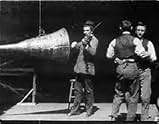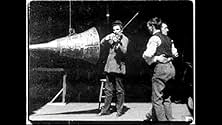NOTE IMDb
6,7/10
2,7 k
MA NOTE
Deux hommes dansent sur un air de violon.Deux hommes dansent sur un air de violon.Deux hommes dansent sur un air de violon.
- Réalisation
- Casting principal
- Récompenses
- 1 victoire au total
William K.L. Dickson
- Violinist
- (non crédité)
Avis à la une
The Library of Congress has discovered the missing sound-track for this film, which was at the Edison National Historical Site all along. It was a cylinder, broken in half, labelled "WKL Dickson Violin with Kineto" and it has recently been repaired, transcribed, and put in synch with the image. This short film now takes its place as the oldest existing sound film. Before the image starts, you can just hear someone saying "Are the rest of you ready? Go ahead!"
There have been several books that have cited this as the earliest gay cinema. I don't really see this as all that gay in the homosexual sense but then seeing two men dancing in what has to be the worlds first movie musical does have its attraction.
There have been several earlier comments about this film dismissing any homosexual overtones. As to those that are quick to dismiss this film as just being silly and an experiment done late at night after too many drinks... Well I've heard that story before.
This film is of interest as an oddity and if folks want to consider it the first gay film so be it. Better this than the depressing 1919 Anders als die Andern.
There have been several earlier comments about this film dismissing any homosexual overtones. As to those that are quick to dismiss this film as just being silly and an experiment done late at night after too many drinks... Well I've heard that story before.
This film is of interest as an oddity and if folks want to consider it the first gay film so be it. Better this than the depressing 1919 Anders als die Andern.
"The synchronized sound version was restored in 2000 by Walter Murch, Rick Schmidlin, Industrial Light and Magic and Skywalker Sound, which is a division of Lucas Digital, Ltd., LLC (a George Lucas company) in collaboration with the Library of Congress and the Edison National Historic Site."....IMDB.
I won't rate this film, as it's just too short and is a purely experimental film that was never released back in the day. It consists of a guy playing the violin into a gigantic cornucopia-like device attached to an Edison cylindrical recording device. As he plays, two guys dance about with each other (in a father familiar manner). Towards the end, some other guy shows up for no apparent reason.
This is not a fun film you should rush to show all your friends. However, it IS historically significant as one of the first sound films...albeit crudely made. Well worth seeing for film historians and nuts like me.
I won't rate this film, as it's just too short and is a purely experimental film that was never released back in the day. It consists of a guy playing the violin into a gigantic cornucopia-like device attached to an Edison cylindrical recording device. As he plays, two guys dance about with each other (in a father familiar manner). Towards the end, some other guy shows up for no apparent reason.
This is not a fun film you should rush to show all your friends. However, it IS historically significant as one of the first sound films...albeit crudely made. Well worth seeing for film historians and nuts like me.
Quite a curiosity both technically and in its content, this very brief experimental film is an important part of the early history of the movies. It shows how very early in the history of cinema that film-makers hoped to synchronize sound with motion pictures, and perhaps also shows how close they came. If an early attempt like this had succeeded in making it possible to create 'talking' pictures while the whole industry was still in its earliest stages, it seems possible that movie history could well have developed in quite different ways than it actually did.
As it has now been reconstructed using more recent technology, from the film footage and the remains of the original sound cylinder, the sound quality is surprisingly good. In itself, it is not all that far from the sound in much later experiments like the 1925 Theodore Case movie starring Gus Visser, and to early part-sound releases like "The Jazz Singer". Since the initial filming succeeded in its goal, the snags with this attempt seem all to have come in playback, when every attempt at synchronization failed, leaving it to much later film-makers to solve that problem.
The unusual content also makes it a curiosity, as is evidenced by the sometimes widely varying responses to it. It would have been more expected for an experiment like this to use amusing but innocuous subject matter, as Case did much later with Visser's vaudeville act.
As short as the footage of this movie is, it has considerable interest as a piece of movie history, and it's even possible that there is still more to be learned about it.
As it has now been reconstructed using more recent technology, from the film footage and the remains of the original sound cylinder, the sound quality is surprisingly good. In itself, it is not all that far from the sound in much later experiments like the 1925 Theodore Case movie starring Gus Visser, and to early part-sound releases like "The Jazz Singer". Since the initial filming succeeded in its goal, the snags with this attempt seem all to have come in playback, when every attempt at synchronization failed, leaving it to much later film-makers to solve that problem.
The unusual content also makes it a curiosity, as is evidenced by the sometimes widely varying responses to it. It would have been more expected for an experiment like this to use amusing but innocuous subject matter, as Case did much later with Visser's vaudeville act.
As short as the footage of this movie is, it has considerable interest as a piece of movie history, and it's even possible that there is still more to be learned about it.
This is a pretty interesting experiment to watch. It's the first ever, still existing attempt, to unite sight with sound. It features two men dancing to a violin player (possibly William K.L. Dickson himself), who is standing next to an Edison recording cylinder, that is capturing the sound.
The sound and images were not linked together as one yet. And it wasn't until recently that the sound and image have been added technically together. It's probably the reason why people hesitate to call this movie the first ever sound picture.
The movie is made by William K.L. Dickson, a assistant to Thomas Edison himself who ordered him to come up with a way to unite pictures and sound. The answer he provided was the Kinetophone, a Kinetoscope (basicly a large wooden box with a peephole in it, so people could watch the moving images) with a cylinder phonograph inside of it, for the sound. This is the first, that we know off, surviving movie-experiments that feature this technique. All of the later movies using this same technique were shot as silent movies and sound effects were recorded later and separately. So the Kinephone was not an attempt to synchronize sound and images but more an attempt to have images accompanied by sound. In some cases, people could even choose from three sound cylinders, featuring 3 different orchestral performances to accompany the images. Only 45 Kinetophones were ever made so you could hardly call the Kinephone a success. Also after this experiment, focus went off to other cinema techniques, mainly regarding movie-projectors.
So the experiment itself obviously did not become a success, also since it took over 30 more years before the first movies with sound were made and commercially released. They just couldn't yet technically synchronize and put the sound and the images together yet at the time and even if they could and techniques would had been available, it would had been a very expensive job to do so. It therefor really isn't the most influential or historically important movies out of cinematic history but it's very interesting to watch, how people constantly tried to improve the quality and techniques of early cinema and movie-making.
8/10
http://bobafett1138.blogspot.com/
The sound and images were not linked together as one yet. And it wasn't until recently that the sound and image have been added technically together. It's probably the reason why people hesitate to call this movie the first ever sound picture.
The movie is made by William K.L. Dickson, a assistant to Thomas Edison himself who ordered him to come up with a way to unite pictures and sound. The answer he provided was the Kinetophone, a Kinetoscope (basicly a large wooden box with a peephole in it, so people could watch the moving images) with a cylinder phonograph inside of it, for the sound. This is the first, that we know off, surviving movie-experiments that feature this technique. All of the later movies using this same technique were shot as silent movies and sound effects were recorded later and separately. So the Kinephone was not an attempt to synchronize sound and images but more an attempt to have images accompanied by sound. In some cases, people could even choose from three sound cylinders, featuring 3 different orchestral performances to accompany the images. Only 45 Kinetophones were ever made so you could hardly call the Kinephone a success. Also after this experiment, focus went off to other cinema techniques, mainly regarding movie-projectors.
So the experiment itself obviously did not become a success, also since it took over 30 more years before the first movies with sound were made and commercially released. They just couldn't yet technically synchronize and put the sound and the images together yet at the time and even if they could and techniques would had been available, it would had been a very expensive job to do so. It therefor really isn't the most influential or historically important movies out of cinematic history but it's very interesting to watch, how people constantly tried to improve the quality and techniques of early cinema and movie-making.
8/10
http://bobafett1138.blogspot.com/
Le saviez-vous
- AnecdotesThe synchronized sound version was restored in 2000 by Walter Murch, Rick Schmidlin, Industrial Light and Magic and Skywalker Sound, which is a division of Lucas Digital, Ltd., LLC (a George Lucas company) in collaboration with the Library of Congress and the Edison National Historic Site.
- Citations
Man: Are the rest of you ready? Go ahead!
- ConnexionsFeatured in The Miracle of Sound (1940)
- Bandes originalesThe Chimes of Normandy
(1877) (uncredited)
(Originally called "Les cloches de Corneville (The Bells of Corneville)"
Written by Robert Planquette
Small section played on violin by William K.L. Dickson
Meilleurs choix
Connectez-vous pour évaluer et suivre la liste de favoris afin de recevoir des recommandations personnalisées
Détails
- Durée
- 1min
- Couleur
- Rapport de forme
- 1.33 : 1
Contribuer à cette page
Suggérer une modification ou ajouter du contenu manquant















